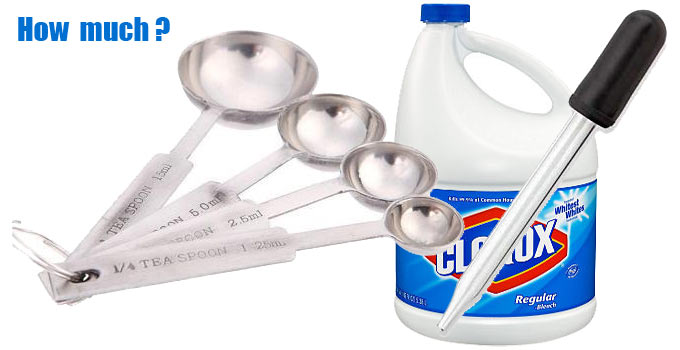How Much Bleach To Purify Water – 55 Gallons – Ratio To Use

If you are storing water in containers, 55 gallon drums, or any bulk size tank or container, how much Regular Chlorine Bleach should you add to purify water?
This has been a common question. I’ve written about it a number of times over the years. I really haven’t changed my opinion about it, however it has been awhile since I brought up the topic. So here we go…
Do I Need To Add Bleach To My Water Storage?
It certainly won’t hurt and it will likely help if you add the right amount of bleach to your long term water storage containment.
If you are sourcing your water from your home’s municipal water supply, the water will already be treated to an extent (a small extent). Note that a typical municipal water supply likely measures between 0.5 and 1.0 ppm chlorine.
If your long term water storage is from your well, there will be nothing to inhibit organic contaminants (if there are any), so it may be a good idea to add some chlorine bleach.
Certainly if sourced from a pond or stream you should treat the water to eliminate organic contamination!
How Much Regular Bleach To Purify Water?
In a previous article, “Bleach – Water Ratio For Drinking Water” I listed the appropriate amount of bleach to add versus how many gallons of water being stored.
(Read on for the amounts…)
This would amount to enough chlorine to eliminate organic contamination from the water while keeping the overall chlorine level within safe limits.
The amounts listed will result in approximately 6 ppm initially, although will decay in time and interaction with organic contaminants.
Note: Important – Use “Regular” bleach (no additives, scents, etc..)
Regular Bleach containing 8.25% Sodium Hypochlorite
1 Quart water, 1 drop bleach
1 Gallon water, 6 drops bleach
5 Gallons water, 1/4 teaspoon bleach
10 Gallons water, 1/2 teaspoon bleach
50 Gallons water, 3 teaspoons bleach
Regular Bleach containing 5 – 6% Sodium Hypochlorite
1 Quart water, 2 drops bleach
1 Gallon water, 8 drops bleach
5 Gallons water, 1/2 teaspoon bleach
10 Gallons water, 3/4 teaspoon bleach
50 Gallons water, 4 teaspoons bleach
How Do I Know When I’ve Added Enough Bleach?
The rule of thumb is this…
If you can detect just a hint of chlorine smell in the water, it’s enough.
The amounts listed above will initially produce approximately 6 ppm, however that figure will drop depending on the chlorine interaction with organic contaminants. It will drop with time too.
You might use an ordinary basic swimming pool chlorine test kit to measure the amount of chlorine in the water.
>> Swimming Pool Chlorine Test Kit
(view on amzn)
Will I Need To Add More Bleach Later?
Bleach will break down after awhile. It actually reduces to salt.
I have read (I believe it was from Clorox) that the potency of regular chlorine bleach will diminish to approximately half strength after ~ 1 year.
That said, if your treated water is sealed in a container and stored properly, there should be no “new” contamination, even after a period of time.
What is “stored properly”?
– Closed up so nothing can get in
– Out of direct sunlight / excessive heat
– Preferably in a relatively cool place
Since chlorine does break down, it wouldn’t hurt to add more if you felt like doing that.
What I generally do is drain and replenish my water storage once a year. When it’s replenished I add chlorine bleach and it’s good to go for another year.
Why do I change my water storage every year?
Although it’s not necessary, because water is water is water, it simply puts my eyeballs on it for ‘just in case’ something went wrong. It makes me feel better…
[ Read: Is Stored Water Safe After One Year? ]
[ Read: Water Sources and Treatment ]
